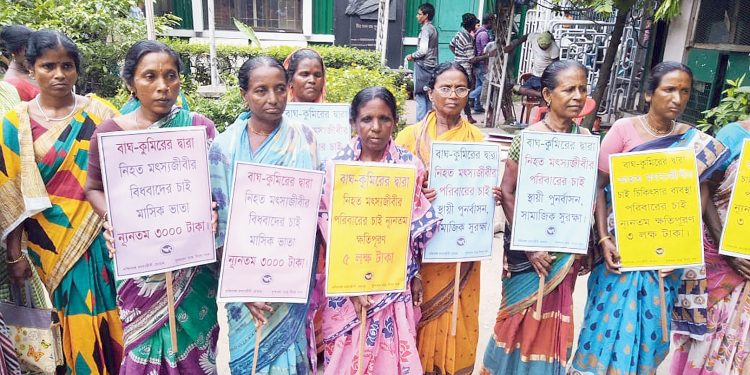Gosaba (West Bengal): Manjula Sardar (45) carrying a bowl of puffed rice and jaggery, her first proper meal in the last two days, wistfully stares at a flooded pond full of saline water.
Cyclone Amphan, which hit West Bengal a week ago, not only killed all the fish in Manjula’s pond, but also snatched away her sole source of livelihood.
This has been her only source of income to feed a family of four for the last seven years ever since a tiger killed her husband in Gosaba area of Sunderbans in 2013.
Manjula, commonly known as ‘tiger widow’ or ‘bagh-bidobha’, is worried how to run her family as the tidal surge created by the cyclone has flooded all the farmlands and ponds in the area, washing away all their means of livelihood.
“After Cyclone Aila, our farmland became barren as saline water had entered the fields. My husband then took to fishing in the creeks of Sunderbans to run the family. It was during a fishing expedition that he was dragged away by a tiger into the forests,” Manjula said.
After much struggle, with the help of an NGO, she was able to use a nearby pond near their one-storey mud-built house for breeding of fish.
“But ‘Amphan’ took away everything. A portion of my house was washed away and the entire pond is now filled with saline water which has killed all the fish. It would take a lot of money and time to restore the pond for fish farming again,” dejected Manjula said.
More than 100 ‘tiger widows’ of the Satjelia block in Gosaba area who had lost their spouses to endangered Royal Bengal Tigers of Sunderbans in the last 15 years also have similar stories of despair to share.
As per official records, 52 human deaths due to tiger attacks have been reported in the Sundarbans from 2010 to 2017.
Shiba Sardar (40), another tiger widow, who hails from Satjelia which is often referred to as ‘Bidhoba Para’ or ‘widows hamlet’, said she is scared of hunger more than any cyclone or dangers of man-tiger conflict.
A short-time poultry farmer, she used to sell full-grown chickens to meat corporations at a profit. “For us, the fight with nature and wildlife is a regular affair. But what hurts most is that every time a disaster hits Sunderbans, we have to rebuild everything from scratch.
“Hundred full-grown chickens and 80 chicks were washed away. The small piece of farmland I have is full of saline water. After the relief distribution ends, how will we survive?” she said.
Shiba’s younger daughter is waiting for her class 10 results, while the elder one is of marriageable age. Embankments in the Sundarban delta — a UNESCO world heritage site — were breached as the surge whipped up by the cyclonic storm inundated several kilometres of the islands with saline water.
“For five to six years after cyclone Aila, nothing would grow in this soil due to the high level of salinity, but things improved in the Sunderbans after the farming of paddy crop Aman began a few years back.
“But now everything is back to square one. With no agricultural land left, I have no means to run my family,” Sulata, who scrapes a living as an agricultural labourer, said. Her husband was killed by a tiger right in front of her in 2011.
According to Sulata, a large number of widows who lost their spouses to tigers, crocodiles and snake bites, have moved to cities and taken up odd jobs to survive.
“I preferred to stay back, as this is my birthplace, and this is where my husband died. But now I think I have to move to the cities to find some work,” she said.
The tiger widows earn around Rs 5,000 to Rs 6,000 a month. With livelihood lost and homes washed away, observers of the Sundarbans feel the ecologically-fragile region which has been under stress due to rising sea levels, needs government intervention.
“The Sunderbans region is completely devastated and these tiger widows are the most vulnerable lot. With no male earning member in their household, these widows face a herculean task of running the families.
“These girls get married at a very early age with very little or no education. There is a need for government assistance to ensure these families survive,” Sushanta Giri of NGO Baikunthapur Tarun Sangha who has worked with tiger widows for more than a decade said.
Sugata Hazra, director, School of Oceanographic Sciences, Jadavpur University, said the government must have a specific policy for disaster-prone areas like Sunderbans.
“Disasters are nothing new in this region. The widows, not just the tiger widows, are the most vulnerable of the affected people. The government must have a specific policy to help this section, rehabilitate and help them start a new life,” Hazra said.
Agriculture, fishing and wildlife tourism are the most predominant livelihood options for around 40 lakh people of the Sundarbans, spread across North 24 Parganas and South 24 Parganas districts of the state.
When contacted, West Bengal Sundarbans Affairs Minister Manturam Pakhira said the government would look into the problems of the widows of Sunderbans. “We would for sure look into their problems. But first and foremost, we have to rebuild everything from scratch as the region had suffered losses worth thousands of crores,” he said.
PTI






































